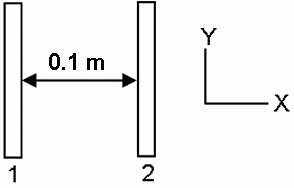Test: Electrostatic Potential and Capacitance - 1 - CUET Humanities MCQ
10 Questions MCQ Test Agriculture Practice Tests: CUET Preparation - Test: Electrostatic Potential and Capacitance - 1
Two insulating plates are both uniformly charged in such a way that the potential difference between them is V2 - V1 = 20 V (plate 2 is at a higher potential). The plates are separated by a distance d = 0.1 m and can be treated as infinitely large. An electron is released from rest on the inner surface of the first plate. What is its speed when it hits the second plate?
(Given: e = 1.6 x 10-19 C, m = 9.11 x 10-31 kg)
(Given: e = 1.6 x 10-19 C, m = 9.11 x 10-31 kg)
In the network shown in the figure given below, C1 = 6μF and C = 9 μF. The equivalent capacitance between points P and Q is

| 1 Crore+ students have signed up on EduRev. Have you? Download the App |
Four large metal plates are located a small distance apart from one another as shown in the figure. The extreme plates are earthed by a conductor, while a potential difference V is applied to the internal plates. Find the magnitudes of the electric fields between the neighbouring plates.


The electrostatic potential energy between proton and electron separated by a distance of 1 Å is
A fully charged capacitor has a capacitance C. It is discharged through a small coil of resistance wire embedded in a thermally insulated block of specific heat capacity s and mass m. If the temperature of the block is raised by ΔT, then the potential difference V across the capacitor will be
A capacitor of capacitance C1 = C is charged to a voltage V. It is then connected parallel to a series combination of two uncharged capacitors of capacitances C2 = C and C3 = C. The charge that will flow through the connecting wires is
In bringing an electron towards another electron, the electrostatic potential energy of the system
On introducing the dielectric medium between the plates of parallel plate capacitor, electrostatic potential
Four metal plates numbered 1, 2, 3 and 4 are arranged as shown in the figure. The area of each plate is A and the separation between adjacent plates is d. The capacitance of the arrangement is

The effective capacitance of two capacitors of capacitances C1 and C2 (with C2 > C1) connected in series is 25/6 times the effective capacitance when they are connected in parallel. The ratio of C2 to C1 is




























